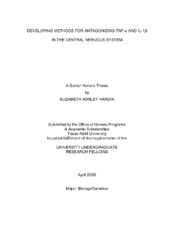| dc.description.abstract | Stressful life events have been linked to the onset, susceptibility, and even progression of neurodegenerative diseases such as multiple sclerosis (MS). Theiler’s murine encephalomyelitis virus (TMEV) infection, a well-characterized animal model of MS, is used in our laboratory to investigate the interaction between social stressors and disease development. Social disruption (SDR), a model of social stress used in our laboratory, appears to worsen Theiler’s virus infection through excessive inflammation. Prior findings from our laboratory indicate that pro-inflammatory cytokine IL-6 is partially mediating the negative effects of SDR in the development of Theiler’s virus infection. In order to examine the role of other pro-inflammatory cytokines, our objective was to develop techniques to block the cytokines TNF-α and IL-1β. Prior studies have indicated stress-induced release of these cytokines (TNF-α and IL-1β) may mediate the adverse effects of disease development in subsequent immune challenges. Balb/cJ mice were implanted with a permanent indwelling cannula in
the left lateral ventricle of the brain and allowed to recover for one week prior to manipulations. Once the animals recovered from cannulation surgery, neutralizing antibody to TNF-α or IL-1β was administered during the period of SDR. Antibody-SDR treatments continued for one week. Mice were sacrificed the morning following last day of SDR. Brains and sera were collected to measure TNF-α or IL-1β levels. Spleens were harvested to examine the development of glucocorticoid resistance (GCR), a hallmark of SDR, in the TNF-α study only. The ELISA assay was not sensitive enough to the tissue levels of TNF-α, therefore successful antagonism was undetectable. In contrast, IL-1β was elevated during SDR; however, it appears that the antibody was only partially effective at the dose administered. The GCR assay indicated that resistance occurred in antibody treated and control mice in the TNF-α study, signifying that antibody treatment does not interfere with the development of normal social stress effects. Future studies are necessary to identify an effective blocking dose for the neutralizing antibody to IL-1β. In addition, we also need to develop alternative assays, such as RT-PCR or an RNase protection assay, that are sensitive to the levels of TNF-α associated with SDR. | en |


